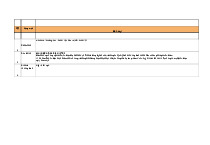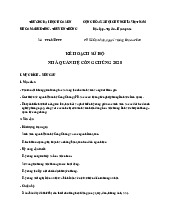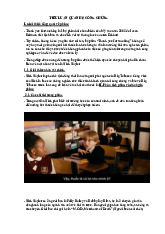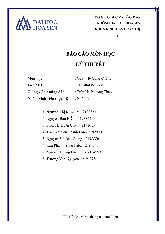












Preview text:
EXPLANATORY AND ARGUMENTATIVE ESSAY ON THE RISK OF
ENTREPRENEURSHIP - THE DEFINITION OF BUSINESS RISK Arif Murrja,
PhD in Economics, Associate Professor,
Faculty of Economy and Agribusiness, Agricultural University of Tirana Agim Ndregjoni, PhD in Economics,
Faculty of Business, University “Aleksandër Moisiu”, Durrës, Albania Pranvera Troka, Candidate of PhD,
Faculty of Economy and Agribusiness, Agricultural University of Tirana Erion Shehu, Master of Science,
Faculty of Economy and Agribusiness, Agricultural University of Tirana
Abstract. Risk is a very important concept for the individual, business, government, society, nature and the
universe as a whole. A risk isn’t the same as a danger.The objectives of the paper are the answers to the following
questions: Is the “risk” different from the “danger”? What is the venture to invest? What are the phenomena
(systematic and specific) that threaten business activity? How should the phenomena be considered, as risk
occurrence (luck, fate, fortune, destiny) or danger occurrence (jeopardy, peril)? Why there is not a standard
definition of business risk?
The purpose of the paper is to formulate a representative and accepted definition for business risk. In
methodological terms, the concept of risk is described in the form of explanatory and argumentative essays. During
essay, you will find highlighted the general and essential features of risk as occurrence and risk as ventures for
investment. After identifying the risk features, the business risk is defined.
Key words: Risk, danger, enterprise, systematik, non-systematic, occurrence (phenomena). INTRODUCTION
In everyday life, especially people who are not educated in the field of
linguistics, business and economics, confuse the meaning of risk and danger.
Therefore, we find it necessary to firstly explain the linguistic meanings of both
words “risk” (luck, fate, fortune, destiny) and “danger” (jeopardy, peril). Then, we
will analyze these words from the perspective.
In business, the risk is treated as a separate occurrence, such as accident at
work, loss of purchasing power and money from inflation, and so on. Nonetheless,
the venture to invest is a risk occurrence, which is threatened by various
phenomena or events (risk and hazard occurrence).
We will refer to the language meanings in Albanian, Greek, Italian, Russsian
and English dictionary to explain that "risk" is not the same as "hazard".
(i) Albanian is part of the indo-european language group. In Albanian language,
risk means luck (good or bad), while danger means difficult situation, jeopardy,
disaster (Thomai, etc., 2006 and “fjalori.shkenca.org”), death.
(ii) As a written language, the Greek is one of the oldest in the world. In Greek,
"τύχη" means luck, (good or bad risk), while "κίνδυνος" means danger (Sinani, 2005: p. 156, 285).
(iii) Italian is the basic language in the group of Latin languages. In Italian,
“rischio, fortuna” means risk, luck; while “pericolo” means danger (Leka &
Simoni, 2000: p. 454, 787,900).
(iv) In Russian, as one of the Slavic languages, "risk" means "риск", while
"danger" means "oпажность".
(v) Nowadays, English is the language of science. In terms of positive or
negative sense, the following words are used in english: (i) "luck" meaning
good luck or bad luck; (ii) "fate" meaning it is destined this way or this is
destiny (iii) "fortune" meaning fate is good or fate is blind; (iv) "hazard,"
meaning casual, betting (Qesku 1999: p. 156, 216). In financial literature, these
words are replaced by the word "risk", the second meaning of which is courage
or acceptance. From the economics point of view, the word "risk" should not be
confused with the words "danger", "jeopardy" and "peril". These words always
mean negative influences and bring ill omens to everyone (Qesku 1999: p. 102, 417). 1.1 -Explanatory essay 1.1.1 -Risk as luck
Risk means luck, fate, chance. For example, this is (was) his/her risk/fate or his
fate was sealed (Thomai, etc., 2006, p. 909 and “fjalori.shkenca.org”). The word
risk is synonymous with the word fate (luck). In the philosophical and religious
meaning, fate (risk) is an unknown power that is believed to inevitably determine
the progress of human life or the course of events; interweaving circumstances or
occasional events in human life; a flow of events ending with a satisfactory end or
not; prosperous or not (even in philosophical units): brought by fate; he/she is (un)
lucky; left to the mercy of fate (someone or something); luckily, fortunately;
unluckily, unfortunately (fjalori.shkenca.org). From this unknown or a supernatural
power called luck or risk, is determined not only the progress of human life, but
also the development of business and society. Risk managers can predict the
positive or negative impacts of this unknown power in business activity.
1.1.2 -Danger as mortal disaster
In unpleasant situations, where our relatives are in the hospital, and the doctor
barges in saying (hopefully): "He is now out of danger (he is not expected to die,
even though he has been extremely ill). Danger means a difficult situation, when
someone or something might experience a great evil (Thomai, etc., 2006: p. 925
and “fjalori.shkenca.org”) as a premature, not natural loss of the lives of humans,
living things, plants and as bankruptcy of business from natural, economic,
sociological phenomena, and so on. It happens that premature losses come from
natural disasters and extreme indifference of individual or individuals. For
example, we can point to premature losses in the lives of people, living things and
plants from seismic vibrations, tsunamis and tornadoes; or premature and unnatural
losses of passengers from irresponsibility of the bus driver, high speed driving
(over the limit). Hence we say: "He was driving so fast that I felt that my life was in danger”.
To prevent the risk of life (death) of people in high-voltage electric power
stations, nuclear power stations and high-risk workplaces is written: Warning!
Danger of death! Stay out! Figure 1, reflects the imagination of danger as a mortal disaster.
Figure 1: Danger as mortality disaster
Source: Images taken on Google, as arguments presented by the authors.
1.1.3 -The difference between risk and danger
The wise folks says: - "You don’t go in and don’t go out the sea on foot". Ferry
lines can be used to travel from one place to another. If we try to go swimming, we
are facing a “danger occurrence”(death) and if we try to go by ferry we are facing
“risk occurrence” (can or can’t do something bad or good). LITERATURE REVIEW
Financial literature often mentions the risk, but there is not an accepted
definition by everyone (Holton). Earlier efforts are made to define risk (Pratt 1964;
Arow 1965). Holton points out two elements (i) individuals who have an interest in
the outcome and (ii) individuals do not know what will happen. By highlighting
these two elements, the risk carries itself exposure and uncertainty.
According to the IIA (Institute of Internal Auditors), the risk is the possibility of
the occurrence of an event that will have an impact on the achievement of the
objectives and is measured according to the impact (consequence) and likelihood
(probability). Almost the same says ISO (International Standardization
Organization): -Risk is the effect of uncertainty over the objectives. The
vocabulary of business describes the risk as: probability to be damaged, loss of
responsibility, return on investment, insurance from various phenomena, loss of
job, etc. (businessdictionary.com). The Oxford English Dictionary definition of
risk is as follows: ‘a chance or possibility of danger, loss, injury or other adverse
consequences’ and the definition of ‘at risk’ is ‘exposed to danger’. In this context,
risk is used to signify negative consequences. However, taking a risk can also
result in a positive outcome. A third possibility is that risk is related to uncertainty
of outcome (Hopkin, 2010, p. 11).The economic times defines risk as an implicit
uncertainty in the future, with respect to the deviation from the expected income or
expected outcome. The risk measures the uncertainty that an investor is willing to
undertake to make a profit from the investment.
In the above paragraph, we had e look at risk perspectives. In their article, Sotić
and Rajić (2014, p. 18) have identified 12 risk definitions by different authors and
institutions, but none of them is representative and widely accepted. The reason is
very simple. The risk is analyzed as an only event, such as fire loss, exchange rate
loss, inflation loss, and so on.
Our goal is to define risk as venture into business. Entrepreneurship itself is a
risk. The business venture risk is exposed and threatened by phenomena or
occurrences that have positive consequences for a business or others, but at the
same time have negative consequences for someone else or others and vice versa. METHODOLOGY
This paper uses descriptive analysis as interlacing the explanatory essay with
arguing essay. Initially, we introduced the explanatory essay of the language
concepts of both “risk”(fate, luck, fortune) and “danger” words (jeopardy, peril) or
death. Subsequently, we have the introduction ofthe argumentative essay on the
concept of risk from a business entrepreneur's point of view. To illustrate the
difference of “risk ”and “danger”, are used images and diagrams. Through imagery
and diagrams, it is clearly explained the imagination of danger as an event, the
imagination of risk as an event and as a venture to invest. Based on the linguistic
arguments, images, business risk chart and the difference of “risk” and “danger” as
an event, the definition of business risk is formulated. DISCUSSIONS 3.1 -Argumentative essay
We will analyze the initiative and the desire of the individual to invest in
business, education, sports and science in few perspectives.
First, the risk is an individual venture to become successful, to become a
successful professional or to become a celebrity in a particular field.
Second, the risk is the part that belongs to someone by chance (entrepreneurship).
Third, the risk is good luck or bad luck.
Fourth, to become someone (rich or famous) by individual entrepreneurship,
your venture is exposed and threatened by natural, biological, economic, political
and war phenomena, which act systematically. Also, entrepreneurship is related to
business (type) and funding mode, phenomena that operate in a non-systematic manner.
3.1.1 -Risk as an individual venture
In Figure 2 we have the risk imagination as venture and as business share. The
expected share to be earned or lost from the enterprise is estimated in cash and
benefits. For example: profit from business is estimated in cash and the satisfaction
of their ownership is estimated in benefit; or the possession of a luxurious villa on
the coast is valued in cash and the pleasure of spending the holidays is valued in benefit.
Figure 2: The risk of entrepreneurship
Source: Images taken on Google, as arguments presented by the authors.
3.1.2 -Risk is good luck (positive or profit) or bad luck (negative or loss)
In a business venture or a sports game, the risk is a profit or loss opportunity,
while in a venture to be educated, the risk is an opportunity to pass or to fail the exams.
Figure 3: Risk is good luck(positive) or bad luck (negative)
Source: Images taken on Google, as arguments presented by the authors.
Figure 3 illustrates the risk imagery as good luck (good) or bad luck (negative).
For example, in the rope crossing venture, one is safe, while the other is unsafe.
Entrepreneurship to walk on the rope and to go to the other side for the lady is
positive, while for the gentleman is negative. When the event impact is positive is
called "good risk", "good luck" or "positive risk" and when it’s negative it’s called
"bad risk", "bad luck" or "negative risk". Therefore, we find in the risk
management literature the uses of the phrases: "positive risk" and "negative risk".
3.1.3 -Risk threats of business venture
The risk of entrepreneurship in the business is threatened by the following
phenomena: natural, biological, economic, political and wars. These occurrences,
if they occur, affect all the spheres of a venture in business and at the same time all
businesses and are exposed as a risk event and as a danger event.
Figure 4 illustrates the phenomena that threaten the risk of entrepreneurship in business.
Figure 4: Risk threats of business venture
Source: Presentation of authors. If the threats of phenomena:
(i) have positive consequences for some and negative consequences for others,
should be treated as a risk event;
(ii) are always negative, but not all of them are to be considered as a risk event
due to catastrophic losses (these are natural disasters);
(iii) are always and for all negative, should be treated as a danger event.
3.1.3.1 -Analysis of natural, biological, economic and political phenomena as a risk event
The fall of snowfall is a natural phenomenon and should be treated as a risk
event because some plants, trees, and creatures need it in order for them to grow;
while some other plants do not need it. At the same time, the snowfall increases the
difficulties in urban transport. Diseases and pests are biological phenomena and
should be treated as a risk event because the pharmaceutical and medical industry
benefits from income; while agricultural producers and sick people lose income.
Domestic currency depreciation is an economic phenomenon and should be treated
as a risk event because exporters earn income, while importers lose income.
Placing flat tax is a phenomenon of fiscal policy and should be treated as a risk
event because wealthy people pay less taxes; while relatively low-income
individuals pay more taxes. The analyzed phenomena, and many such as these, are
risk events because they bring benefits for some groups (positive impacts) and
losses for some others (negative impacts).
3.1.3.2 -Analysis of natural and biological disasters
Natural occurrences such as fire, flood, collapse, earthquake, tsunami, cyclone
and tornado; or epidemic events should be considered a danger event. Natural
disasters and epidemics always have negative consequences, but not for everyone.
For example, seismic vibrations always have negative consequences: for families
and businesses where it happens, but not for the whole society.
Figure 5: Post earthquake situation and negative consequences (danger event)
Source: Images taken on Google, as arguments presented by the authors.
The survival and continuity of life in the future will create positive effects on
businesses that will sell raw materials, products and services for the rebuilding of
the city. Survivors will benefit from economic and social treatments from the
government. Recovery of life after natural disaster should be treated as a positive risk event.
Figure 6: Post earthquake situationand positive consequences
Source: Images taken on Google, as arguments presented by the authors.
3.1.3.3 -Analysis of natural, biological and economic phenomena as a danger event
The occurrences classified as dangerous events remain the same: the Earth's
scourge of different asteroids, the loss of solar heat, global warming, the depletion
of water resources, the destruction of the oxygen and the recession of the global
economy. If these phenomena occur they have negative impacts on everyone
(individual, business, government, society, and the Earth). Their exposures and
threats have been and are major concerns for yesterday and today's scientists.
Figure 7: Always and to all dangerous
Source: Images taken on Google, as arguments presented by the authors.
3.1.3.4 -Business risk chart
Systematic risks that operate equally are presented in Figure 4. But business
venture is also exposed to non-systemic risks, including the risk of production,
market risk, legal risk and human resource risk (Crane etc., 2013: p. 8, 15, 23, 30,
35 and Turay, 2015, p. 3). Kravchenko (2018, p.194) focuses on "scientific non-
knowledge". He quotes Chernobyl U. Beck: “The nuclear explosion was
accompanied by an explosion of non-knowledge… What used to count as knowing
is becoming non-knowing, and non-knowing is acquiring the status of knowledge”.
Also, similar ‘explosions’ occur more or less regularly in all sciences –
yesterday's ‘universal’ knowledge in the form of a ‘true’ paradigm nowadays is
‘ageing’ and due to added innovations produces scientific non-knowledge. Here
the non-knowledge is not ignorance but a kind of higher knowledge presupposing
the existence of hypothetical risks. In real life we have a paradoxical combination
of various kinds of knowledge and non-knowledge making the dispersion of ‘old’
and modern risks (Kravchenko, 2018, p. 194). Part of production risk is industrial
risk. Postelnicu and Câlea (2019: p. 195-206 ), emphasize: (i) Velocity: unlike the
previous industrial revolutions, this one is evolving at an exponential rather than
linear pace; (ii) Breadth and depth: we will have to reconsider an entire range of
paradigms that we are familiar with; (iii) Systems impact on society as a whole.
Specifically for agribusiness enterprises (Nitsenko, 2019, p. 3) underlines: … in
most cases the seasonal unevenness of cash inflows is inherent for agriculture. This
creates certain requirements for the planning of costs, the need to take into account
the risks associated with the seasonal character of production. Such a tool as
futures sales are not yet widespread in the economic activities of agribusinesses, so
they do not remove the problem of seasonal nature of proceeds. The occurrences to
be treated as systematic and non-systematic risks are presented in Figure 8.
Figure 8: The risks of entrepreneurship
Source: Presentation of authors.
Figure 9: Systematic and non-systematic business risk NON- SYSTEMATI C RISK Production risk Market risk Legal risk Human risk Fiancial risk SYSTEMA TIC RISK The impact of the event Natural risr Biological risk Economic- risk Political risk Armed conflicts's The probability of the event
Source: Presentation of authors.




